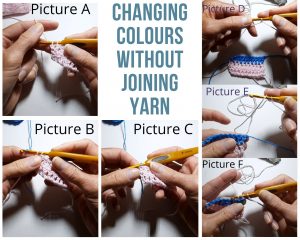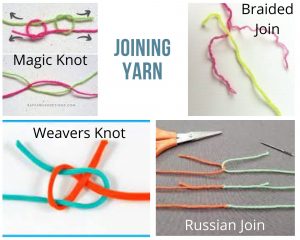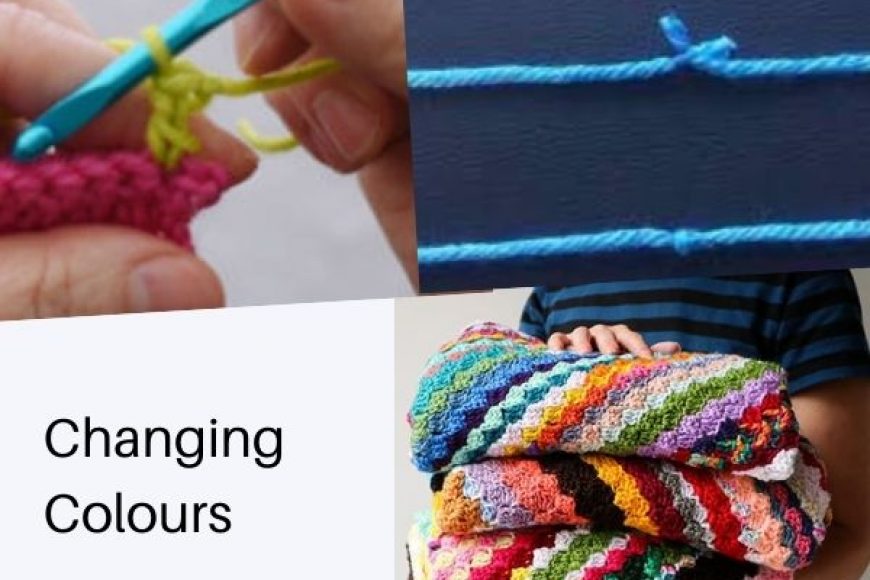Changing Colours May 2021
Colourful crocheted items are a great way to use up your scrap yarn, but what about all those colour changes? What is the most effective way of changing colours with yarn (or even adding in a new ball)?
The number one thing is to avoid tying knots! These leave bumps in your work, and it is often hard to ensure that the new colour begins in the spot you want. Below is a technique that I use, and works whether you are changing colours at the beginning of a row, in the middle of a row or even just joining a new ball of the same colour. It can be used for any stitch, but I have illustrated it using the treble crochet, and at the end of a row.
Work in the existing or first colour until the last stitch before you wish to change colours. For the last stitch, work the stitch until there are two loops left on your hook [picture A] (at this stage there is one yarn over to complete to finish the stitch). Work the last yarn over with the new colour you are changing to [picture B]. Then begin your turning chain or next stitch with the new colour [picture C]. You may need to pull on the first colour yarn so it doesn’t come loose as you begin the chain/next stitch. Once you’ve completed the row, and you don’t intend to use that colour again soon, and you are happy that the pattern is right, cut the first yarn, leaving a tail and sew in that end and the end of the new colour.
Another approach when introducing a new colour on a new row is to fasten off in the old colour (particularly if you do not want to carry the old yarn colour), and then begin your new colour with a ‘standing stitch’. This technique is beneficial when you are working in the round and want to vary the starting point of each round, which will in turn help to avoid the ‘line’ appearing in your work. The standing stitch begins with an actual stitch replacing the need to slip stitch and then do 3 chain. The technique does require a little more coordination and can be done with any stitch, but i’ve illustrated it below with a standing treble.
want to carry the old yarn colour), and then begin your new colour with a ‘standing stitch’. This technique is beneficial when you are working in the round and want to vary the starting point of each round, which will in turn help to avoid the ‘line’ appearing in your work. The standing stitch begins with an actual stitch replacing the need to slip stitch and then do 3 chain. The technique does require a little more coordination and can be done with any stitch, but i’ve illustrated it below with a standing treble.
Start with a slip knot on your hook. With your finger hold that loop still [Picture D] while you yarn over. Hold this yarn over as well and insert your hook into the desired starting place [Picture E], yarn over and pull the yarn back through that place [Picture F]. Complete your stitch as normal.
You can also watch a video demonstrating these two methods. Some people prefer to join the yarn itself. Some of these methods include:
Some people prefer to join the yarn itself. Some of these methods include:
Magic Knot – This is a strong knot and there is no need to weave in the ends once tied – they can be cut off close to the knot. It can be easily done in the middle of a row and not be seen. There is also no need for any other tools. It involves tying two knots and pulling them together. However as with any knot it can leave a ‘bump’ in your work and so needs to be used in the right place where it can be hidden
Weavers Knot – This is also a strong knot, that needs no tools, and once completed, the ends of the yarn can be trimmed close to the knot so there is no need to weave in the ends. Like the magic knot it can be easily done in the middle of a row and not be seen.
Russian Join – This is a little fiddlier and requires a darning needle that is no thicker than the yarn you
are using. Like the magic knot there is no need to weave in ends once completed. It creates a very
sturdy knot. However it does create a thicker looking yarn around the join, therefore needs to be
used with care.
Invisible Braided Join – This is a variation of the Russian Join, but instead of using a needle to thread
the ends of the yarn back into itself, the end of the yarn is split and braided back into the yarn.
Compared to the Russian join, the yarn does not get that thicker appearance around the join, and is
therefore great for lacy work.

